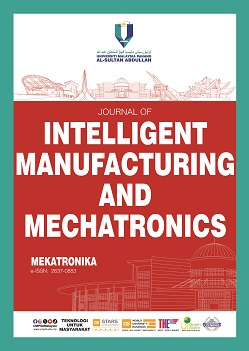Mechanomyography in Assessing Muscle Spasticity: A Systematic Literature Review
DOI:
https://doi.org/10.15282/mekatronika.v6i1.10204Keywords:
Mechanomyography, Muscle Spasticity, Quantitative Assessment, Neurological DisordersAbstract
Mechanomyography (MMG) has gained significant prominence in the domain of scientific inquiry, exhibiting widespread applications in diverse areas including sensor advancement, signal processing methodologies, characterization of muscle spasticity, diagnosis of neurological disorders, and as a valuable tool in medical rehabilitation. However, despite the considerable body of existing MMG research, there remains a paucity of comprehensive investigations in these domains in the past. The primary objective of this systematic review is to conduct a comprehensive analysis of the available literature pertaining to the evaluation of muscle spasticity assessment using mechanomyography (MMG) in a systematic and categorical manner. By applying the pre-established search criteria to five prominent databases, a total of 63 pertinent studies that met the inclusion criteria for our review. Through a thorough scrutiny of the 10 meticulously selected records, we unveiled the extensive diversity in protocols and parameters employed in the assessment of muscle spasticity using mechanomyography (MMG). Accelerometers and piezoelectric sensor used for mechanomyography (MMG) are currently in the nascent phase of their development, as evidenced by the findings of this systematic review. Notably, this review also highlights the influence of sensor placement on muscles as a potential factor affecting the acquired signal. In consideration of these findings, it can be concluded that further research is warranted to advance MMG, particularly in the domains of sensor refinement, with specific attention to accelerometers, and the refinement of signal processing techniques. Additionally, future investigations should aim to expand the scope of MMG applications in clinical settings and rehabilitation practices.
References
M. A. Islam, K. Sundaraj, R. B. Ahmad, N. U. Ahamed, and M. A. Ali, “Mechanomyography sensor development, related signal processing, and applications: A systematic review,” IEEE Sens J, vol. 13, no. 7, pp. 2499–2516, 2013, doi: 10.1109/JSEN.2013.2255982.
A. Thibaut, C. Chatelle, E. Ziegler, M. A. Bruno, S. Laureys, and O. Gosseries, “Spasticity after stroke: Physiology, assessment and treatment,” Brain Inj, vol. 27, no. 10, pp. 1093–1105, 2013, doi: 10.3109/02699052.2013.804202.
J. W. Lance, “The control of muscle tone, reflexes, and movernenk Robert Wartenbeg Lecture.”
R. Lochhead and R. E. Bristol, “Spasticity,” in Encyclopedia of the Neurological Sciences, Elsevier Inc., 2014, pp. 242–244. doi: 10.1016/B978-0-12-385157-4.00783-1.
Y. Cha and A. Arami, “Quantitative modeling of spasticity for clinical assessment, treatment and rehabilitation,” Sensors (Switzerland), vol. 20, no. 18, pp. 1–22, Sep. 2020, doi: 10.3390/s20185046.
B. Petek Balci, “Spasticity Measurement.,” Archives of Meuropychiatry, vol. 55, no. Supplement 1, pp. S49–S53, 2018.
C. Wang et al., “Quantitative Elbow Spasticity Measurement Based on Muscle Activation Estimation Using Maximal Voluntary Contraction,” IEEE Trans Instrum Meas, vol. 71, 2022, doi: 10.1109/TIM.2022.3173273.
Z. J. Billington, A. M. Henke, and D. R. Gater, “Spasticity Management after Spinal Cord Injury: The Here and Now,” J Pers Med, vol. 12, no. 5, May 2022, doi: 10.3390/jpm12050808.
A. Ahmad Puzi, S. N. Sidek, H. Mat Rosly, N. Daud, and H. Md Yusof, “Modified Ashworth Scale (MAS) Model based on Clinical Data Measurement towards Quantitative Evaluation of Upper Limb Spasticity,” in IOP Conference Series: Materials Science and Engineering, Institute of Physics Publishing, Nov. 2017. doi: 10.1088/1757-899X/260/1/012024.
M. S. Erden, W. McColl, D. Abassebay, and S. Haldane, “Hand Exoskeleton to Assess Hand Spasticity,” in Proceedings of the IEEE RAS and EMBS International Conference on Biomedical Robotics and Biomechatronics, IEEE Computer Society, Nov. 2020, pp. 1004–1009. doi: 10.1109/BioRob49111.2020.9224329.
E. Santos, E. Krueger, G. N. Nogueira-Neto, and P. Nohama, “Comparison of Modified Ashworth Scale with Systems and Techniques for Quantitative Assessment of Spasticity- Literature Review,” J Neurol Disord Stroke, vol. 5, no. 2, pp. 1–9, 2017, [Online]. Available: https://pdfs.semanticscholar.org/cb25/a36e71801913a17d513865f6b18e0e6ade6e.pdf
M. Correa, M. Projetti, I. A. Siegler, and N. Vignais, “Mechanomyographic Analysis for Muscle Activity Assessment during a Load-Lifting Task,” Sensors, vol. 23, no. 18, Sep. 2023, doi: 10.3390/s23187969.
C. Meagher et al., “New advances in mechanomyography sensor technology and signal processing: Validity and intrarater reliability of recordings from muscle,” J Rehabil Assist Technol Eng, vol. 7, p. 205566832091611, 2020, doi: 10.1177/2055668320916116.
M. Szumilas, M. Władziński, and K. Wildner, “A coupled piezoelectric sensor for mmg-based human-machine interfaces,” Sensors, vol. 21, no. 24, 2021, doi: 10.3390/s21248380.
I. Talib, K. Sundaraj, and C. K. Lam, “Choice of mechanomyography sensors for diverse types of muscle activities,” Journal of Telecommunication, Electronic and Computer Engineering, vol. 10, no. 1–13, pp. 79–82, 2018.
C. Journal, N. Alves, and T. Chau, “JNER JOURNAL OF NEUROENGINEERING AND REHABILITATION The design and testing of a novel mechanomyogram-driven switch controlled by small eyebrow movements,” of NeuroEngineering and Rehabilitation, vol. 7, p. 22, 2010.
E. Cè, S. Rampichini, E. Limonta, and F. Esposito, “Torque and mechanomyogram correlations during muscle relaxation: Effects of fatigue and time-course of recovery,” Journal of Electromyography and Kinesiology, vol. 23, no. 6, pp. 1295–1303, 2013, doi: 10.1016/j.jelekin.2013.09.007.
R. Uwamahoro, K. Sundaraj, and I. D. Subramaniam, “Assessment of muscle activity using electrical stimulation and mechanomyography: a systematic review,” BioMedical Engineering Online, vol. 20, no. 1. BioMed Central Ltd, Dec. 01, 2021. doi: 10.1186/s12938-020-00840-w.
H. Tsuji et al., “Quantification of patellar tendon reflex using portable mechanomyography and electromyography devices,” Sci Rep, vol. 11, no. 1, pp. 1–15, 2021, doi: 10.1038/s41598-021-81874-5.
S. de POL, E. B. Neves, A. E. Lazzaretti, S. M. Smaili, and E. Krueger, “Punctual mechanical oscillation in modulation of muscular tonus in children with spasticity,” Bioscience Journal, vol. 37, pp. 1–11, 2021, doi: 10.14393/BJ-v37n0a2021-53574.
C. T. Pan, C. C. Chang, Y. S. Yang, C. K. Yen, Y. H. Kao, and Y. L. Shiue, “Development of MMG sensors using PVDF piezoelectric electrospinning for lower limb rehabilitation exoskeleton,” Sens Actuators A Phys, vol. 301, p. 111708, 2020, doi: 10.1016/j.sna.2019.111708.
S. W. Jun, S. J. Yong, M. Jo, Y. H. Kim, and S. H. Kim, “Brief report: Preliminary study on evaluation of spasticity in patients with brain lesions using mechanomyography,” Clinical Biomechanics, vol. 54, pp. 16–21, 2018, doi: 10.1016/j.clinbiomech.2018.02.020.
E. Krueger, E. M. Scheeren, G. N. Nogueira-Neto, V. L. D. S. N. Button, and P. Nohama, “A new approach to assess the spasticity in hamstrings muscles using mechanomyography antagonist muscular group,” Proceedings of the Annual International Conference of the IEEE Engineering in Medicine and Biology Society, EMBS, pp. 2060–2063, 2012, doi: 10.1109/EMBC.2012.6346364.
da Luz dos Santos, E. et al. (2020). “Mechanomyography Spasticity Assessment of Flexor and Extensor Wrist Muscles for the Classification of Boccia Athletes in Para Sports: A Pilot Study,” VIII Latin American Conference on Biomedical Engineering and XLII National Conference on Biomedical Engineering. CLAIB 2019, doi: 10.1007/978-3-030-30648-9_154.
N. Campbell, T. Egan, and C. Deegan, “The application of digital accelerometers for wired and non-wired Mechanomyography,” 2017 28th Irish Signals and Systems Conference, ISSC 2017, pp. 0–6, 2017, doi: 10.1109/ISSC.2017.7983619.
H. Wang et al., “Assessment of elbow spasticity with surface electromyography and mechanomyography based on support vector machine,” Proceedings of the Annual International Conference of the IEEE Engineering in Medicine and Biology Society, EMBS, no. Table 1, pp. 3860–3863, 2017, doi: 10.1109/EMBC.2017.8037699.
E. L. Santos, M. C. Santos, E. Krueger, G. N. Nogueira-Neto, and P. Nohama, “Mechanomyography signals in spastic muscle and the correlation with the modified Ashworth scale,” Proceedings of the Annual International Conference of the IEEE Engineering in Medicine and Biology Society, EMBS, vol. 2016-Octob, no. Ll, pp. 3789–3792, 2016, doi: 10.1109/EMBC.2016.7591553.
M. K. Liu, Y. T. Lin, Z. W. Qiu, C. K. Kuo, and C. K. Wu, “Hand Gesture Recognition by a MMG-Based Wearable Device,” IEEE Sens J, vol. 20, no. 24, pp. 14703–14712, 2020, doi: 10.1109/JSEN.2020.3011825.
E. Krueger, E. M. Scheeren, G. N. Nogueira-Neto, V. L. D. S. N. Button, and P. Nohama, “Advances and perspectives of mechanomyography,” Revista Brasileira de Engenharia Biomedica, vol. 30, no. 4, pp. 384–401, 2014, doi: 10.1590/1517-3151.0541.
M. O. Ibitoye, N. A. Hamzaid, J. M. Zuniga, N. Hasnan, and A. K. A. Wahab, “Mechanomyographic parameter extraction methods: An appraisal for clinical applications,” Sensors (Switzerland), vol. 14, no. 12, pp. 22940–22970, 2014, doi: 10.3390/s141222940.
Downloads
Published
Issue
Section
License
Copyright (c) 2024 The Author(s)

This work is licensed under a Creative Commons Attribution-NonCommercial 4.0 International License.




